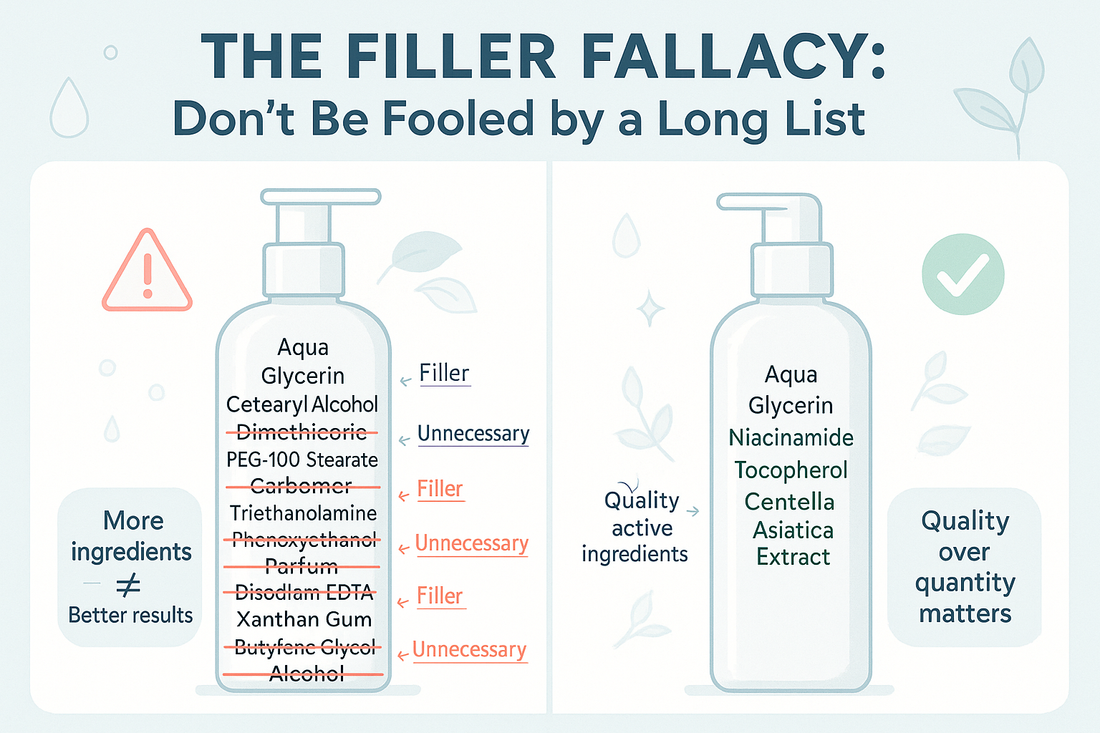
The Filler Fallacy: Why That "Magical" Ingredient List Might Be Hiding the Truth
TrueBliss SkincareYou're standing in the beauty aisle, reading the back of a skincare product. The front promises "miraculous results" and "cutting-edge science." The ingredient list is long, filled with an exciting array of botanical extracts and high-tech compounds. It sounds incredible, and the price tag suggests it must be. You buy it, full of hope. But what if that impressive list is hiding a disappointing truth?
This is the Filler Fallacy—the deceptive practice of using a vast number of ingredients, many in insignificant amounts, to create an illusion of potency and value. While the front of the bottle is selling a dream, the back is often telling a different, far less effective, story.
What are "Filler Ingredients"?
Filler ingredients aren't necessarily harmful. They are simply ingredients included in such minuscule concentrations that they have no real impact on your skin. They serve a different purpose: to pad the ingredient list and give the product a more "premium" or "scientifically advanced" appearance.
The cosmetic industry is not required to list ingredients in order of concentration, but by a general rule: ingredients are listed in descending order of concentration, except for those at concentrations less than 1%, which can be listed in any order. This is where the deception lies. A brand can include a dozen high-status ingredients, each at a concentration of 0.01% (or even less!), and list them proudly on the label, making the product look far more potent than it is.
The Problem with the Fallacy
The Filler Fallacy creates a number of problems for consumers:
-
Overpromising and Under-Delivering: You're paying a premium for what you believe is a potent cocktail of active ingredients. In reality, you're mostly buying water, a few basic stabilizers, and some low-cost moisturizers, with the "miracle" ingredients having no real effect on your skin.
-
Increased Risk of Irritation: A long list of ingredients increases the likelihood of a negative reaction. Even if an ingredient is in a tiny amount, it can still be an irritant for sensitive skin. The more ingredients, the higher the chance of your skin reacting poorly to one of them.
-
Confusion and Misinformation: The sheer length of the ingredient list makes it difficult for consumers to identify which ingredients are actually doing the work. You might think you're getting a powerful dose of a certain botanical, when in reality, it's just a sprinkle added for marketing purposes.
How to Decode a Deceptive Ingredient List
Becoming a savvy consumer requires a bit of detective work. Here’s how you can see through the filler fallacy:
-
Look for Top-Tier Actives: Effective ingredients, such as Hyaluronic Acid, Vitamin C, Salicylic Acid, or Retinol, should be near the top of the ingredient list (or at least within the first 5-8 ingredients), not at the very end. The closer an ingredient is to the beginning of the list, the higher its concentration.
-
Don’t Be Seduced by Exotic Names: A product can list a rare berry from the Amazon, but if it's the last ingredient on the list, it's likely just a token inclusion. Focus on what's in high concentration, not what sounds most exotic.
-
Less Can Be More: Don't equate a long ingredient list with a better product. A simple, well-formulated product with a few key, high-quality ingredients can be far more effective than a complex one filled with fillers. When a brand focuses on a few key ingredients, they are often used in high, effective concentrations.
The next time you're shopping for skincare, look beyond the marketing claims on the front of the bottle. Turn it over, read the ingredient list with a critical eye, and seek out brands that prioritize potency and honesty over a deceptive display of fillers. Your skin deserves better than a fallacy.
